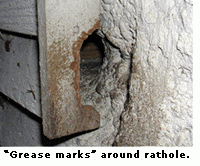Norway Rats
(Rattus norvegicus)
(Rattus norvegicus)

Norway rats, also known as brown rats or sewer rats, are one of the most common and formidable pests worldwide. These rodents are notorious for their adaptability and resilience, thriving in various environments from rural to urban areas. Characterized by their brown-grey fur, small eyes, and blunt noses, Norway rats pose significant health risks and property damage, making them a serious concern for homeowners and businesses alike.
Norway rats, also known as brown or sewer rats, are one of the most adaptable creatures on the planet. They can be identified by their distinct physical characteristics:
Understanding these physical characteristics can help in correctly identifying Norway rats and implementing appropriate pest control measures. If you suspect a Norway rat infestation, contact Willard’s Pest Control for professional assistance.

Norway rats are notorious for being secretive and nocturnal, making their infestations hard to notice until they’ve significantly multiplied especially as nocturnal animals with most of their activities occurring one-half hour after sunset and one-half hour before sunrise. However, there are several signs that can indicate their presence:
If you notice any of these signs, contact Willard’s Pest Control immediately. Our team of professionals is equipped to handle rat infestations swiftly and effectively.
Norway rat infestations can occur due to a variety of reasons. Here are some common factors that can attract these pests to your property:
Preventing a Norway rat infestation involves managing these factors. Regular cleaning, sealing potential entry points, and proper food storage can go a long way in keeping these pests at bay. If you suspect an infestation, contact Willard’s Pest Control immediately. Our team is equipped to handle rat problems efficiently and effectively.
Norway rat infestations pose significant problems, not just to your property, but also to your health. Here are some of the issues associated with these pests:
At Willard’s Pest Control, we understand the severity of a Norway rat infestation. Our team is dedicated to providing effective solutions to keep your home or business safe and pest-free. If you suspect a rat problem, don’t hesitate to contact us.
Willard’s Pest Control Company was established in 1987 as a one-person family operation. Today, 32 years later, we are a growing family run exterminator company employing 30+ people for our pest control services. We specialize in all types of pest treatment services, including bed bugs, ants, cockroaches, and more.
We believe in providing safe, honest work to the Greater Puget Sound and Kittitas County communities and are actively involved in the Washington State Pest Management Association. Through this association, we work to promote professionalism and safety within the extermination industry.